Match the pictures (1-6) with six words from the list below.
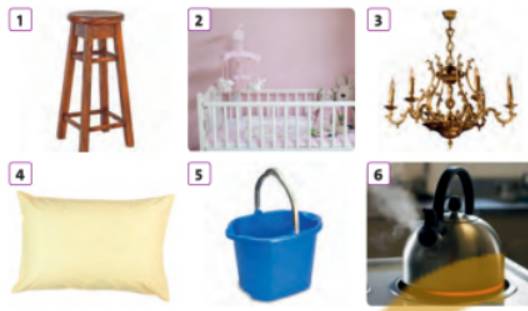

VOCABULARY Match 1-14 in the photo with parts of the body from the list below. Check the meaning of all the words in the list.
Parts of the body
ankle | blood | bottom | brain | calf | cheek |
chin | elbow | eyebrow | eyelid | forehead | heart |
heel | hip | intestine | jaw | kidney | knee |
lung | muscle | nail | neck | rib | scalp |
shin | shoulder | skin | skull | spine | stomach |
thigh | throat | thumb | toe | waist | wrist |
1. ankle: mắt cá chân
2.wrist: cổ tay
3. calf: bắp chân
4. elbow: khuỷu tay
5. shoulder: vai
6. neck: cổ
7. cheek: má
8. forehead: trán
9. heel: gót chân
10. shin: ống quyển
11. knee: đầu gối
12. thigh: đùi
13. chin: cằm
14. thumb: ngón cái
SPEAKING Match the photos with two clubs from the list below. Which clubs from the list would you like to belong to? Give reasons.

School clubs
art club | astronomy club | baking club |
computer club | photography club | film club |
fitness club | school choir | science club |
Picture 1: photography club (Ảnh 1: câu lạc bộ nhiếp ảnh)
Picture 2: school choir (Ảnh 2: dàn đồng ca của trường)
I would like to take part in a photography club and a fitness club. The reason I chose photography club is because I want to learn more skills to take beautiful pictures because I'm not good at it. I love fitness club because I think I can do more exercise and improve my mental health and physical health there.
(Tôi muốn tham gia câu lạc bộ nhiếp ảnh và câu lạc bộ thể hình. Lý do tôi chọn câu lạc bộ nhiếp ảnh vì tôi muốn học thêm kỹ năng để chụp những bức ảnh đẹp vì tôi không giỏi về nó. Tôi thích câu lạc bộ thể hình vì tôi nghĩ rằng tôi có thể tập thể dục nhiều hơn và cải thiện sức khỏe tinh thần cũng như thể chất của mình ở đó.)
1. Match the words in the box with places 1-14 on the map of London below. There are six extra words. Then listen and check.
(Nối các từ trong khung với các địa điểm 1 – 14 trên bản đồ của Luân Đôn bên dưới. Có 6 từ thừa. Sau đó nghe và kiểm tra.)
square | restaurant | school | office building |
train station | bridge | café | theatre |
sports centre | library | bus station | cinema |
shop | park | shopping centre | Market |
monument | hotel | flat | street |
At the British (1)____________, there are fourteen million books!
Regent's (2)____________is a beautiful green area.
The Savoy is a very famous (3)_________.
Nelson's Column is a tall (4)__________ in the middle of Trafalgar (5)__________.
Harrods is a very famous (6)___________.
Victoria (7)_________ - London buses stop here.
Convent Garden - go shopping in the (8)_________s.
The IMAX (9)__________ - watch a 3D film here.
New Malden, eat interesting Korean food in the (10)________here.
King’s Cross (11)_________ - take a train here.
The West End is London's (12)_________district.
Tower (13) ________- see the River Thames from here.
The Shard ________is London's new and very tall (14)_____________.




At the British (1)_____library_______, there are fourteen million books!
Regent's (2)____park________is a beautiful green area.
The Savoy is a very famous (3)___hotel______.
Nelson's Column is a tall (4)____monument______ in the middle of Trafalgar (5)__square________.
Harrods is a very famous (6)____shop_______.
Victoria (7)__bus station_______ - London buses stop here.
Convent Garden - go shopping in the (8)____market_____s.
The IMAX (9)____cinema______ - watch a 3D film here.
New Malden, eat interesting Korean food in the (10)___restaurant_____here.
King’s Cross (11)___station______ - take a train here.
The West End is London's (12)__theatre_______district.
Tower (13) __brigde______- see the River Thames from here.
The Shard ________is London's new and very tall (14)_______office building______.
(1) Library
At the British (1) Library, there are fourteen million books!
(Ở Thư viện Anh, có 14 triệu sách.)
(2) Park
Regent's (2) Park is a beautiful green area.
(Công viên Regent’s là một vùng xanh sạch đẹp.)
(3) hotel
The Savoy is a very famous (3) hotel.
(Savoy là một khách sạn rất nổi tiếng.)
(4) monument; (5) Square
Nelson's Column is a tall (4) monument in the middle of Trafalgar (5) Square.
(Nelson’s Column là một tượng đài cao ở giữa quảng trường Trafalgar.)
(6) shop
Harrods is a very famous (6) shop.
(Harrods là một cửa hàng rất nổi tiếng.)
(7) bus station
Victoria (7) bus station - London buses stop here.
(Trạm xe buýt Victoria – xe buýt Luân Đôn đỗ lại tại đây.)
(8) market
Convent Garden - go shopping in the (8) markets.
(Vườn Convent –đi mua sắm ở chợ nơi đây.)
(9) cinema
The IMAX (9) cinema - watch a 3D film here.
(Rạp chiếu phim IMAX – xem phim 3D tại đây.)
(10) restaurant
New Malden, eat interesting Korean food in the (10) restaurant here.
(New Malden, thưởng thức ẩm thực Hàn Quốc độc đáo ở nhà hàng này.)
(11) station
King’s Cross (11) station - take a train here.
(Nhà ga King’s Cross – đón tàu hỏa tại đây.)
(12) theatre
The West End is London's (12) theatre district.
(West End là khu nhà hát của Luân Đôn.)
(13) Bridge
Tower (13) Bridge - see the River Thames from here.
(Tower Bridge – ngắm sông Thames từ đây.)
(14) office building
The Shard is London's new and very tall (14) office building.
(Shard là tòa nhà văn phòng rất cao và mới của Luân Đôn.)
VOCABULARY Match the photos (A-H) with art forms from the list below. In your opinion, which art form needs the most skill and which the least? Give reasons, using the phrases below to help you.
Art forms ballet cartoon classical music dance drawing mime musical
novel opera painting play poem pop music sculpture sitcom
You have to (be able to) ... in order to...
It’s very difficult to ... / It isn’t that difficult to ... / It’s relatively easy to ...
It doesn’t take much practice to ... / It takes a lot of practice to ...
In my opinion, ballet requires the most skill, and sitcoms require the least.
You have to have a high level of technical proficiency, physical strength, and emotional expression in order to be a good ballet dancer. It takes a lot of practice to achieve the level of proficiency.
Sitcoms don't necessarily require the same level of technical skill or physical prowess as ballet. It's relatively easy to learn the basics of comedic timing and acting, and with a bit of practice, one can become a competent sitcom actor.
(Theo tôi, múa ba lê đòi hỏi nhiều kỹ năng nhất và hài kịch tình huống đòi hỏi ít kỹ năng nhất.
Bạn phải có trình độ kỹ thuật cao, sức mạnh thể chất và biểu cảm cảm xúc để trở thành một vũ công ba lê giỏi. Phải thực hành rất nhiều mới đạt được mức độ thành thạo.
Phim sitcom không nhất thiết đòi hỏi trình độ kỹ thuật hoặc sức mạnh thể chất như múa ba lê. Tương đối dễ dàng để học những điều cơ bản về thời gian và diễn xuất hài hước, và với một chút luyện tập, người ta có thể trở thành một diễn viên hài kịch tình huống có năng lực.)
IV. Read the text below. Complete the gaps (1-3) with appropriate words A-F from the box to obtain a
grammatically and lexically correct text. Fill in the gaps with appropriate letters. There are three
extra words that do not match any of the gaps.
A. invented
B. designed
C. discovered
D. planned
E. first
F. early
CALENDARS
These days, everybody uses calendars to note important dates like birthdays, but when did we start
measuring time?
Until recently, experts believed that people in the Near East made the 1) ………………..……. calendar
5,000 years ago. However, they then 2) ………………..……. an ancient site in Scotland from over
10,000 years ago. At the site, there were 12 holes in the ground. Scientists think that people
3) ………………..……. them to track the movement of the Moon and measure time. It’s an exciting discovery because it shows that people had calendars many centuries ago.
Match the words (1 - 5) with the pictures (a - e).
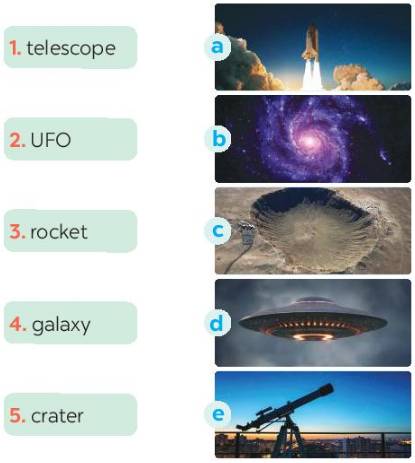
1. telescope
2. UFO
3. Rocket
4. Galaxy
5. Crater
1.telescope
2.UFO
3.Rocket
4.Galaxy
5.Crater
Work in pairs. Discuss and match the three planets in 3 with the pictures (1 - 3) below.
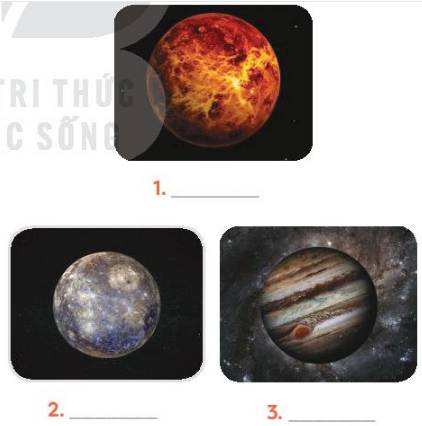
1. Venus
2. Mercury
3. Jupiter
Read the article and look at the pictures. Match the underlined words in the article with pictures 1-4.
A gut feeling?
Emotions do not just occur in your mind; they also have a physical effect on your body. A group of scientists from Finland decided to find out which emotions affect which parts of the body. They asked 701 volunteers to colour in silhouettes in response to emotional words, stories and videos. The results show that the people generally experience emotions like anger, envy and shame in similar ways.
For example, when you're angry, you probably feel that anger mostly in your chest and head. But if you feel ashamed, you probably notice it in your face and, in particular, your cheeks. Depression makes your whole body feel less active, whereas happiness affects your whole body in a positive way.
'Hot' colours like yellow and red show an increase in activity, while blue shows the opposite. Black is neutral.
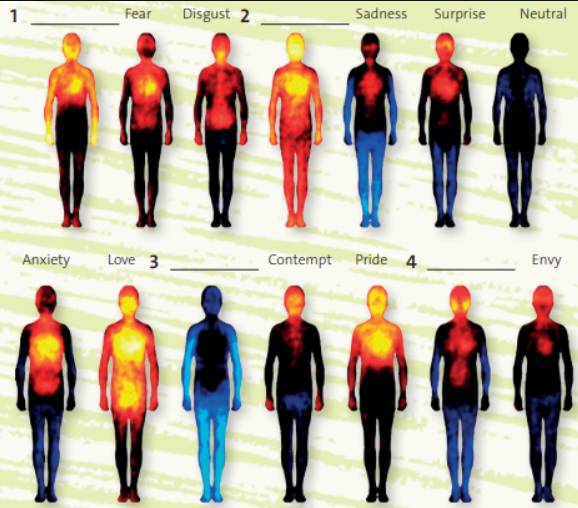
1. anger (tức giận)
2. happiness (vui vẻ)
3. depression (trầm cảm)
4. shame (ngượng)
Match the words and phrases with the pictures.
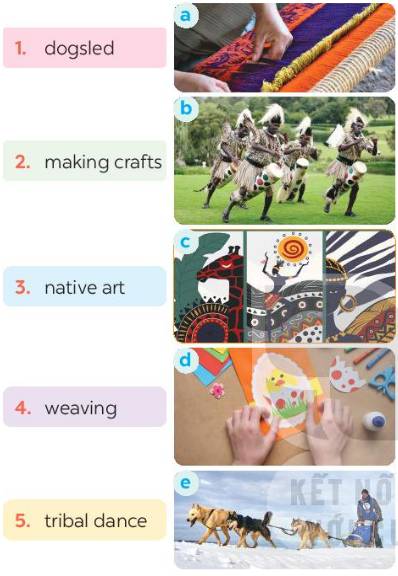
1 – e.
2 – d.
3 – c.
4 – a.
5 – b
1 – e. dogsled: xe trượt tuyết do chó kéo
2 – d. making crafts: làm đồ thủ công
3 – c. native art: tranh vẽ của người bản địa
4 – a. weaving: dệt vải
5 – b. tribal dance: vũ điệu của bộ tộc ít người